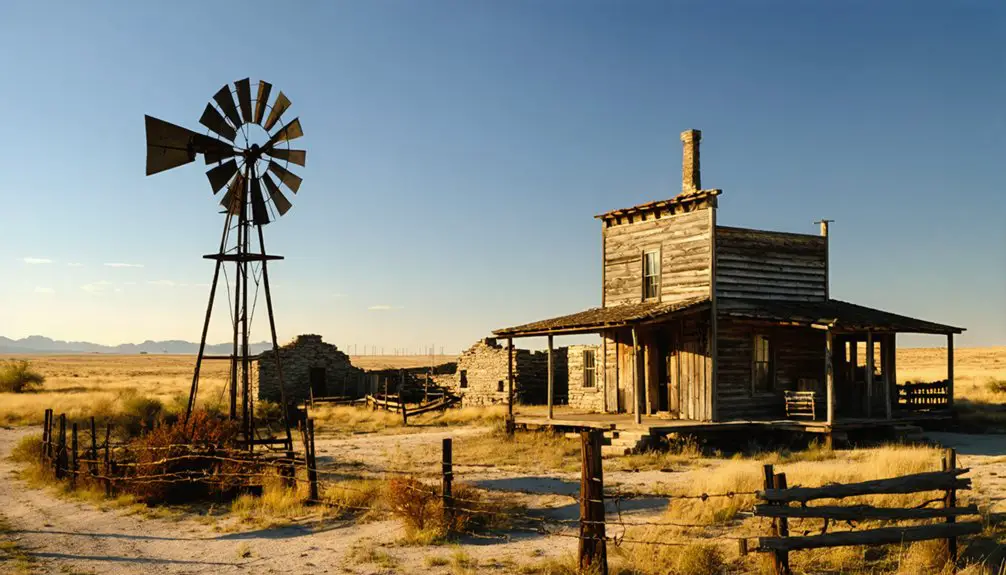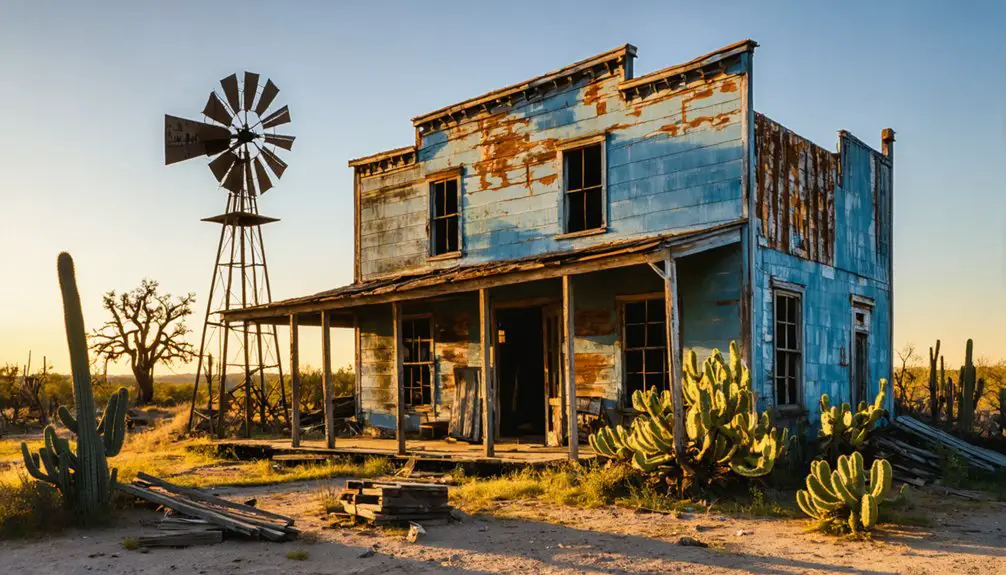You’ll find Benton City’s ghost town ruins 27 miles southwest of San Antonio in Atascosa County, Texas. Established in the 1840s as a stagecoach stop, it thrived with over 300 residents by 1904, featuring the two-story Benton City Institute, businesses, and a Masonic lodge. The town declined after being bypassed by the railroad in 1881, followed by a typhoid epidemic and devastating fire. Today, the stone schoolhouse and historic cemetery preserve its frontier legacy.
Key Takeaways
- Benton City was established in the 1840s along the Old San Antonio Road and reached its peak population of 300 residents by 1904.
- The town declined after being bypassed by the International-Great Northern Railroad in 1881, followed by a devastating typhoid epidemic in 1887.
- The two-story stone Benton City Institute, built around 1875, remains as the most prominent structure of this ghost town.
- Located 27 miles southwest of San Antonio, the ghost town site now lies mostly on private property requiring permission for access.
- The Benton City Cemetery, established in 1870, preserves the legacy of early Texas pioneers and remains accessible for historical research.
The Birth and Naming of a Texas Settlement
Along the historic Old San Antonio Road in Atascosa County, Texas, Benton City emerged as a promising settlement in the 1840s.
Pioneer families like the Lytles, Joneses, Calks, and McDonnells established roots in this strategic location, where agriculture and ranching sustained early growth. The name choice parallels the town in Washington state, which was also named for Senator Benton.
The settlement’s naming origins point to two potential sources: Missouri Senator Thomas Hart Benton, a vocal champion of westward expansion, or Samuel L. Benton, a Texas Revolution hero with local connections. To avoid confusion with other locations sharing this name, historians use place name disambiguation to distinguish this ghost town from other Benton Cities.
You’ll find both theories deeply woven into the town’s historical fabric, reflecting Texas’s tradition of honoring political and military figures.
Life in Late 19th Century Benton City
Life in Benton City flourished during the late 19th century, building upon its pioneering foundations.
You’d find a vibrant community centered around the two-story Benton City Institute, where students studied everything from basic education to law and surveying. Local businesses lined the streets – cotton gins, grocery stores, a drug store, and craftsmen’s shops kept the economy humming.
Community gatherings thrived at the Masonic lodge on the Institute’s second floor, while churches dotted the landscape. The Institute’s impressive construction featured walls of yellow rock that stood over a foot thick, providing a fortress-like presence in the town.
You could catch up on local news through the Benton City Era newspaper or meet travelers at the hotel and livery stable. The stagecoach brought mail several times weekly, connecting you to the outside world via the Old San Antonio Road. The town reached its peak with a population over 300 by 1904.
This golden era showcased Benton City’s peak as a modest but self-sufficient Texas town.
From Bustling Town to Abandoned Settlement
Despite its promising start, Benton City’s fortunes took a dramatic turn when the International-Great Northern Railroad bypassed the settlement in 1881. You’ll find that this missed opportunity sparked a chain of economic challenges that would plague the town for decades.
By 1887, a devastating typhoid fever epidemic struck the community, filling the cemetery so quickly that a new one had to be established the following year. Similar to the town of Elizabethtown, only a muddy field and cemetery remain of what was once a thriving community.
The town’s decline accelerated through multiple setbacks: a destructive downtown fire demolished crucial businesses, the population dropped from 300 to 200 between 1904 and 1914, and health crises drove away potential settlers. The arrival of paved roads in nearby areas further diminished Benton City’s importance as a local hub.
Preserved Ruins and Historic Sites
You’ll find the most prominent remains of Benton City in its two-story stone schoolhouse, constructed around 1875 and operated until the 1930s when it merged with the Lytle district.
The historic Benton City Cemetery, established in 1870, contains the graves of area pioneers and veterans from various conflicts, though it’s now situated on private land with restricted access.
These preserved structures, along with scattered foundations and chimneys throughout the area, serve as physical evidence of the once-thriving community’s 19th-century infrastructure.
Historic School Building Remains
The stone ruins of Benton City Normal Institute stand as a memorial to pioneer-era education in Texas, with its remaining walls marking the location east of Benton City Cemetery near FM 3175 in present-day Lytle.
Built in 1875, the educational architecture featured irregular rocks and mortar construction strong enough to support two stories of activity. The building’s distinctive thick stone walls remain over a foot wide, demonstrating the durability of 19th-century construction methods.
You’ll find evidence of its multi-purpose design, where the ground floor served classrooms while Masonic Lodge 379 occupied the upper level until 1909.
The building’s community significance grew as it evolved from Benton City Institute to Benton School (1889) and Old Rock School (1910).
Though the state recognized it as a historic site
Cemetery and Pioneer Graves
Resting among quiet fields east of FM 3175, Benton City Cemetery stands as an essential historic landmark containing approximately 153 recorded memorials from the town’s pioneering era.
You’ll find pioneer burials dating back to the late 1800s, including veterans who served in Indian warfare, the Civil War, WWI, and WWII.
As one of the few surviving remnants of this ghost town, the cemetery preserves the legacy of Benton City’s original settlers through weathered headstones and family plots. James M. Jones, a prominent farmer and citizen, established this first public cemetery in Lytle in 1870.
Cemetery preservation efforts continue through documentation by state authorities and local historians, maintaining this crucial connection to South Texas frontier life.
The grounds serve as an outdoor heritage museum where you can trace the evolution of early settlement patterns and military service histories that shaped Atascosa County’s development.
James and Debbie Collins have undertaken an extensive restoration project spanning one and a half years to repair damaged headstones and clean the grounds.
Legacy in Texas History

While many Texas ghost towns have faded into obscurity, Benton City‘s legacy endures as a tribute to frontier settlement patterns and transportation’s impact on community survival. Founded in the 1840s along the Old San Antonio Road, the town’s name reflects both political influence and military heritage, honoring either Senator Thomas Hart Benton or Texas Revolution hero Samuel L. Benton.
You’ll find Benton City’s story mirrors the rise and fall of numerous Texas frontier communities. From its heyday as a thriving stagecoach stop with cotton gins, mills, and shops in the 1880s, to its decline following the railroad’s bypass to Lytle, the town exemplifies how transportation shaped Texas settlement. The town’s slow decline was marked by the school consolidation in 1919 when its high school merged with the Lytle school district.
The surviving Benton City Institute building and pioneer cemetery stand as representations of the community’s role in early Texas development.
Visiting Benton City Today
Visitors exploring Benton City today will find a stark contrast to its once-bustling past. The ghost town exploration requires careful planning, as you’ll need to navigate rural access roads about 27 miles southwest of San Antonio.
Abandoned and eerily quiet, Benton City’s remote ruins beckon adventurous explorers willing to venture down dusty backroads near San Antonio.
While the site offers fascinating glimpses into Texas history, much of it lies on private property, including the old courthouse and jail ruins.
For a successful visit to this remote location, remember:
- Respect private property boundaries and obtain necessary permissions
- Bring essential supplies, as no facilities or services exist onsite
- Document historical structures carefully, but keep safety in mind around crumbling ruins
The two abandoned cemeteries and remaining stone chimneys serve as silent witnesses to Benton City’s decline, offering poignant reminders of how railroad decisions shaped Texas settlement patterns.
Frequently Asked Questions
Are There Any Documented Ghost Stories or Paranormal Activities in Benton City?
You’ll find no officially documented ghost sightings, though local folklore mentions unexplained sounds at the Institute building. No formal paranormal investigations exist, just unverified visitor accounts from the cemetery and ruins.
What Happened to the Families Who Lived in Benton City?
You’ll find these families relocated to nearby towns like Lytle, driven by displacement effects from railroad changes and school closures. Their family legacies live on through the cemetery and scattered regional descendants.
Were Any Valuable Artifacts Ever Discovered in the Abandoned Town?
While time has turned the pages, you won’t find records of valuable artifact discoveries in the ruins. Unlike neighboring sites, the town’s historical significance lies in its structural remains rather than precious finds.
Did Any Famous Historical Figures Ever Visit Benton City?
You won’t find records of notable visitors in Benton City’s historical archives, though its placement on Old San Antonio Road meant travelers passed through during its brief period of significance.
What Native Tribes Originally Inhabited the Area Before Benton City’s Settlement?
Like ancient footprints in time, you’ll find the Caddo were primary inhabitants, while Comanche, Wichita, and Tonkawa tribes also called this region home before European settlement transformed the landscape.
References
- https://en.wikipedia.org/wiki/Benton_City
- https://www.youtube.com/watch?v=udY3uBRi0vM
- https://www.desertedtexas.org/2015/05/benton-texas/
- https://www.desertedtexas.org/tag/benton-city/
- https://en.wikipedia.org/wiki/List_of_ghost_towns_in_Texas
- https://www.texasalmanac.com/places/benton
- https://www.texasescapes.com/SouthTexasTowns/Benton-Texas.htm
- https://www.vanishingtexas.net/the-benton-city-institute-near-lytle-texas/
- https://www.historylink.org/file/10389
- https://www.tshaonline.org/handbook/entries/benton-city-institute



